The Portland Bureau of Transportation has come up with an infrastructure solution to car users who do donuts and drive recklessly through neighborhoods.
The residential intersection of Southeast Woodward and 59th has an extremely wide opening that measures about 85-feet — that’s over three times the width of a standard neighborhood street. In large part because of that width, people have shared concerns with PBOT about dangerous drivers who speed around the intersection while sliding out their rear tires. This type of behavior is risky on any street, but SE Woodward is a neighborhood greenway popular with bike riders, walkers, and runners.
To remedy this issue, PBOT identified a small amount of funding through their Multimodal Missing Links program, a small and flexible pot of money the city uses to address hot spots and fill minor gaps in the network. The annual budget of the program is about $200,000.
In March of last year, PBOT reached out to people who live in the South Tabor Neighborhood to learn more about the Woodward and 59th intersection and present design concepts that would address its issues. They decided to build a traffic island in the middle of the intersection using 12-inch wide, 4-inch high concrete curb separators (similar to ones used on protected bike lanes citywide). The curbs will reduce the amount of space available for car users and create a more predictable flow of traffic. Most importantly, if someone tried to do a donut, they’d slam into the curbs and severely damage their car.
Local advocate David Binnig snapped a photo of the completed separators and shared it today on the Bike Loud Slack channel. He also shared a before photo that shows skidmarks.
I wrote an opinion piece in 2022 that encouraged PBOT to use basic traffic calming treatments like this to address street takeovers and burnouts. It’s great to see them take action and address this problem with a cheap and easy solution.
Now all that’s left is to do something with that space in the middle of the island. Folks on Bike Loud suggested it would be a perfect spot for a lemonade stand, some potted plants, or a shuffleboard court. It’s amazing what’s possible when we reclaim our streets from dangerous people and their vehicles!
UPDATE, 2/21 at 4:30 pm: PBOT has added signage, paint, and reflective wands to the curbs to increase visibility. Photo below by Liza Norment via Bluesky.


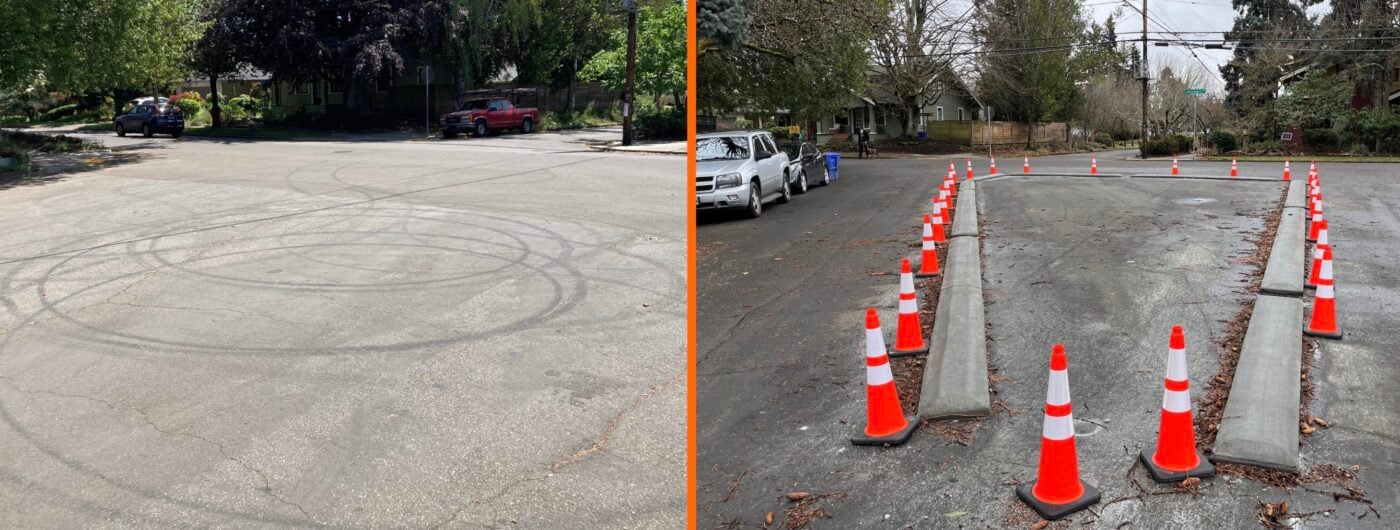
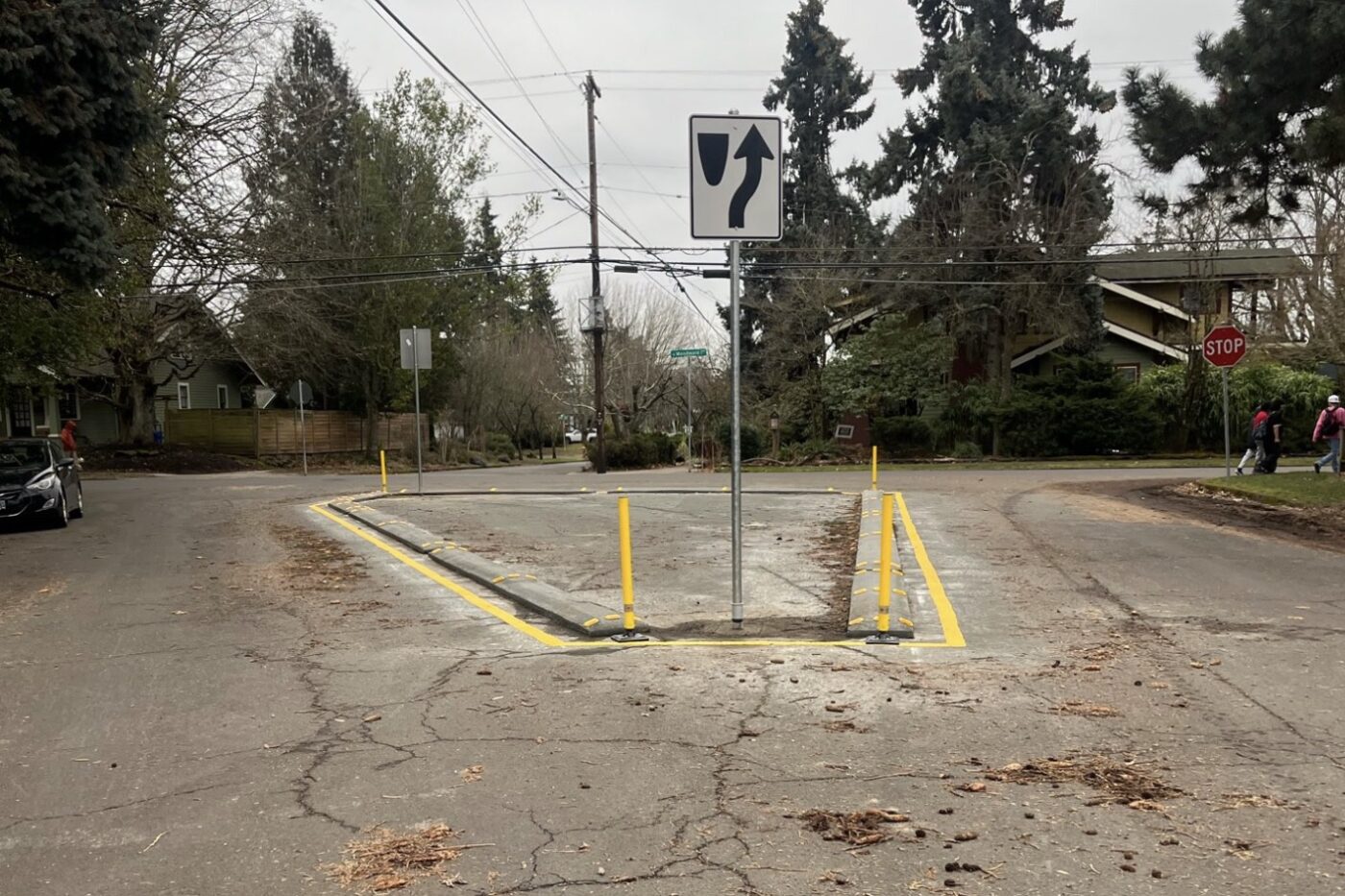
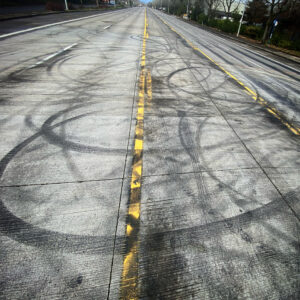
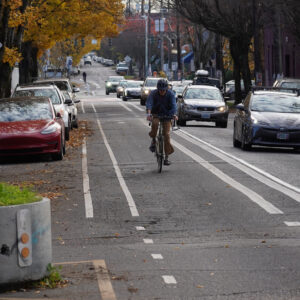

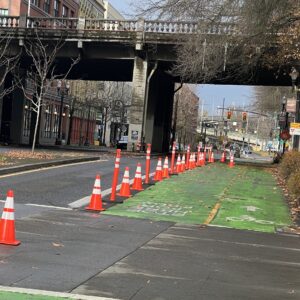
Thanks for reading.
BikePortland has served this community with independent community journalism since 2005. We rely on subscriptions from readers like you to survive. Your financial support is vital in keeping this valuable resource alive and well.
Please subscribe today to strengthen and expand our work.
Now tear out all the pavement on the inside and plant some groundcover, no view blocking bushes, please.
A small community garden would be nice too. There’s a years-long wait for plots at the Mt. Tabor community garden so there’s demand. I imagine there’s utilities running under the street though, so tearing out the pavement might not be an option.
Yea! Forward to depave.
It now looks like a basic skateboard park.
I remember seeing an old Portland trolley map where the turnout was designed as a terminus for one of the trolley lines, hence its shape.
It looks so clearly like one but when I brought up this intersection with a streetcar geek, they drew the opposite conclusion. I would love to find that old thread on Reddit.
Now that I’m seeing it again, the trolley was actually a couple blocks to the east, on 63rd I think. The odd shape may be more to re-align a jog on 59th where it crosses Woodward. According to the property line maps, the area was developed around or after 1942.
A skate park would rip here! Not sure how the neighbors would feel about it though.
I always wondered why the intersection was so big – a trolley turnaround makes a lot of sense.
If you really hate the neighbors, put in a pickleball court.
I’m thinking a tent and a couple old sofas will show up before long. Maybe an “unlicensed bicycle disassembly operation”
This is great to see, as cheap and low-tech traffic calming is so great. The recent snowstorm revealed all the sneckdowns around town and had me thinking about all the opportunities. NE 84th and Davis has an “intersection triangle mini park“ with a nice tree in it that the neighbors started having a happy hour in during Covid. Portland needs more mini parks!
NE 84th & Davis:
https://maps.app.goo.gl/XqXrKY5EBTfWY2jp9
NE 72nd & Jonesmore has another, huge & open (ex-trolley track?) intersection that could use a similar curb treatment. You can even see the tire donut marks from space!
https://maps.app.goo.gl/TjawoZJMx7hT6Uvb6?g_st=com.google.maps.preview.copy
Agree – the 72nd & Jonemore/Broadway spot is very similar and would also benefit from something like this. But i also worry that in that location installing some kinds of curbs would invite tents.
Nice! This is crying out for de-paving the median that’s been created, and doing some landscaping. I’m guessing that this is not part of the PBoT budget for this…
Perhaps they could get some Parks budget for that
Heck yeah PBOT!!!!!! This looks like a model project to make a difference cheaply.
If only they would install these down 79th and Powell, RVs have been performing the, “park for multiple months and trash the sidewalk” off and on for years now.
Sorry, choosing to live in drug-addled squalor is a protected class in Portland, the elites have spoken for us all. Whatever you do, keep paying taxes and voting for DSA candidates
That missing link funding and those seven concrete curb segments could have been used to install 3 diverters.
Sorry, but that’s a terrible solution – a dangerous solution for cyclists, runners, walkers, and even drivers who won’t see the low curbs and will smash into them and lose control and crash and be injured or die. And then CoP – actually we, the taxpayers – will be on the hook to pay out for injuries.
The solution is to un-widen the street in a way that people expect, with planters or collapsible guardrails or something else large and visible to all road users. Portland is full of these klugey and dangerous road treatments that are designed to confuse road users and injure them – something I learned when my kids were learning to drive and I watched them try to figure out all of the non-standard crap that PBOT builds.
If you’re cycling on this street in the dark, will you see these curbs? Why would you even expect there to be curbs in this location?
This is a good point; it’s an invisible hazard blocking the most appealing path for cyclists.
I cycled on this street in the dark last night; yes, I saw the curbs.
Given that the orange cones are still up in the photo, I’m wondering if this isn’t done yet, and that PBOT will be adding paint, reflectors, and/or wands. Turning it into a landscaped island long-term might be ideal.
PBOT is actually out there today adding signage and reflectors! But I’ve biked through there at night several times and the curbs are visible in the dark, even without reflectors.
The uglification continues.
Would it be so difficult for them to add some landscaping instead of just yellow paint and concrete?
I’d guess not remarkably more difficult. On the other hand, the money to do that could go to other safety improvements elsewhere.
And the concrete (and likely at least some of the signage and reflectors) would be needed even if it were landscaped.
PBOT NOT doing landscaping seems logical and responsible.
You’ve got a point, but I don’t think this is as dangerous as you make it out. I think removing the asphalt and planting a couple of large trees would make this more legible. They could also improve the street lighting. Ultimately, adding this space between the sidewalk and curb to allow for large street trees would be ideal, but the Portland Standards curb detail is very expensive/linear foot so I can see why they are not doing that.
See DW’s comment above about utilities.
The city is probably the most expensive builder when it comes to installing curbs for two reasons: they price in lots of planning, design, and general overhead, and also the curb price may actually include storm sewer inlets and branch lines which are literally a whole other level of cost.
ODOT is charging $33 million/mile along the outer Powell Boulevard for a roadway rebuild that replaces the existing 3-lanes + bike lanes with 3-lanes + curbed bike lanes + sidewalks + storm sewers. The roadway already has household sewers and a major water main/aqueduct.
This actually looks like a good example relevant to the “we don’t need infrastructure, we need enforcement” argument. If it works, it will stop the bad behavior there much more effectively and cheaply than policing.
Nope. We need both infrastructure AND enforcement. . And with a $100 million dollar deficit, additional infrastructure is going to be long in coming.
What are you talking about? I didn’t say a thing about doing only infrastructure. Saying infrastructure looks like it will work in this case is not saying it’s the solution everywhere.
Again, what are you talking about? I didn’t say a thing about doing massive amounts of infrastructure.
For a few thousand dollars, this project looks like it will eliminate the need for any cop to ever come to this location again to stop drifting/donuts–which doesn’t work well anyway unless the people doing it stay long enough to be caught. It also has some other safety benefits on top of that–defining lanes, slowing traffic…
This cheap project frees police to do enforcement elsewhere. And it cost the Police budget nothing.
Hmmm, and I wonder what a household might have to do if they didn’t get the raise they wanted and with inflation taking a big bite out of what a dollar can buy?
Maybe they’d have to travel less, cut out avocado toast for breakfast, not buy that new phone this year, etc. You get the picture.
Well time PBOT does the same. Do they need so many people in their Communications department? If PBOT isn’t doing anything what are they going to communicate out about?
How about administrators take care of their own calendars and get rid of their executive assistants?
How about not repaving streets yet again just because a PBOT exec drives on them and doesn’t like the potholes?
I’m sure there are tons, just ask most PBOT employees. I know a few and they could come up with plenty, but their bureau head isn’t very good being a convicted felon and all. She has a nickname at PBOT, but I won’t bore you with what it is.
I imagine they will also post one or two signs – Keep right, like they do on my diverters. Plus add reflectors on the curbs. Would be nice to consider a longer term solution, like a median that can grow a significant tree. That would be fabulous!
Why not remove the asphalt in that island to plant shrubs and trees?
Third paragraph of the article (emphasis mine):
Can someone explain to me how this treatment is different from the various concrete planters PBOT removed recently because drivers were recklessly driving into them? My experience at 53rd and Irving has become noticeably worse since that planter was removed. Won’t drivers inevitably run into these curbs and damage them and their cars? Why is this worth the effort to maintain but not the other infrastructure they removed?
It would be nice to get a clear message from PBOT about their goals and for them to follow through with them. I’m guessing the difference between this and the other removed safety infrastructure is complaint based like how a lot of Portland is run. Hopefully that changes with our new council and city manager.
The goals seem crystal clear to me:
Nextdoor/NA homeowners complain about intersection diversion slowing down their precious SUV: barrels removed and program cancelled
Nextdoor/NA homeowners complain about young people marring their precious roadway: 7 curbs installed using very limited dedicated funds that would normally go to barrels/diverters
Here’s the thing: just because you call your design “traffic calming”, it doesn’t mean it doesn’t create a new hazard.
Some of the stuff PBOT has tried just plain does not work. The barriers at 92nd & Lincoln are a good example, accidents are way up at that intersection since it was “calmed”. I’m talking cars-in-yards and that sort of thing.
Any evidence for your claim or is it just feels? That’s my neighborhood and that intersection was really dangerous before. The idea that people are crashing because the street was narrowed suggests people are still driving poorly and too fast through there not that the barriers are causing accidents. If you can’t see a brightly painted concrete barrier with reflectors on it and you run into it you shouldn’t be driving.
Materially how are these curbs any different than the planters they removed from other intersections? Do you think these curbs are just as dangerous?
These curbs probably aren’t all that dangerous to drivers as they are designed to have cars roll right over them accompanied by a jolt that will range from invigorating in a sedan to barely noticeable in a lifted pickup.
They are far more dangerous to cyclists and riders of various small electric vehicles as they will almost certainly cause any rider that hits them to crash.
These SEVEN concrete curbs do absolutely nothing to calm traffic on the actual neighborhood greenway (Woodward) which was the entire purpose of those milquetoast sewer barrels.
This project is more about coddling noisy neighborhood association members than creating an environment that is friendly to transportation alternatives.
Great example of how to do more with less. Given all the budget shortfalls the city is facing, this sort of out of the box thinking is needed!
The center of this would be a great spot for a few LTN boxes!
Beautiful! More of this.
I deem this new feature the Triangle of Sadness